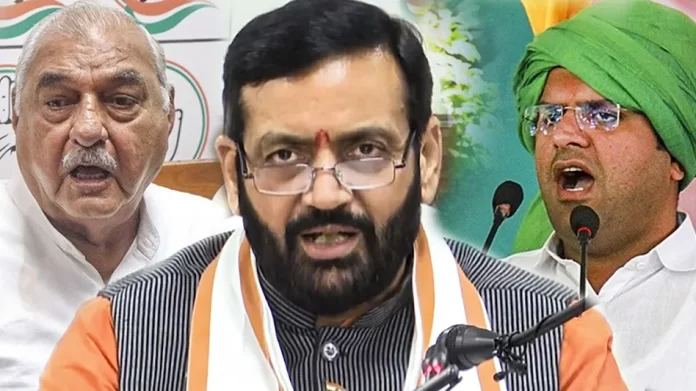New Delhi, 11th September. As the Haryana Assembly election draws closer, the political landscape is charged with anticipation. The ruling Bharatiya Janata Party (BJP), having been in power for nearly a decade, is facing significant anti-incumbency. With a multi-cornered contest on the horizon, the BJP is preparing for a battle against the Congress, while several regional parties, such as the Aam Aadmi Party (AAP), Samajwadi Party (SP), Communist Party of India (Marxist) [CPI(M)], and the Haryana Lokhit Party, also vie for influence in the state.

The alliances formed among various parties have added to the complexity. The BJP, Jananayak Janata Party (JJP), and Azad Samaj Party (Kanshi Ram) have come together, with Dushyant Chautala emerging as the alliance’s chief ministerial candidate. Meanwhile, the Indian National Lok Dal (INLD) and the Bahujan Samaj Party (BSP) have allied, positioning Abhay Singh Chautala as their chief ministerial hopeful.
BJP’s Challenges: Anti-Incumbency and Eroding Vote Share
One of the most notable dynamics in this election is the BJP’s challenge of overcoming anti-incumbency sentiment. In the 2019 Assembly elections, the BJP secured 40 seats, six short of a majority, and had to rely on Dushyant Chautala’s JJP for support. However, with the JJP having recently ended its alliance with the BJP, the ruling party is left to rebuild its strategy from scratch.
A critical indicator of the BJP’s decline in popularity is its diminishing vote share. In the 2019 Lok Sabha elections, the party won all ten seats in Haryana, a remarkable performance by any standard. However, by 2024, its dominance was eroded, with the BJP and Congress each winning five seats. This steep fall in the BJP’s vote share—from 58.2% in 2019 to 46.11% in 2024—is particularly alarming for the party. The decline is widely attributed to the farmers’ protests spearheaded by the Samyukt Kisan Morcha, where the demand for a legal guarantee of Minimum Support Price (MSP) created widespread discontent among Haryana’s agricultural community.
Furthermore, the BJP’s efforts to gain traction with the Jat community have not been successful. This significant voting bloc has drifted away from the BJP, further complicating the party’s prospects.
Congress: Buoyant After Gains in Lok Sabha Polls
The Congress, led by former Chief Minister Bhupinder Singh Hooda, is sensing a strong opportunity to return to power after ten years. The party’s confidence is bolstered by its improved performance in the 2024 Lok Sabha elections, where it doubled its seat tally compared to 2019. Congress is betting on a platform focused on key issues such as unemployment, inflation, farmers’ concerns, and opposition to the Agniveer scheme.
Another important factor for the Congress is its engagement with young voters. With over 452,000 first-time voters and 4.09 million young voters across the state, the party is targeting this demographic with promises of welfare measures, such as a Rs 6,000 pension for senior citizens and 300 units of free electricity.
The Role of Regional Players
Regional parties are playing a crucial role in this election. While BJP and Congress are the major contenders, parties like AAP, SP, and CPI(M) are hoping to carve out a share of the electorate. AAP, under the leadership of Arvind Kejriwal, holds sway in areas bordering Delhi and could impact the outcome in several constituencies. Despite the legal challenges facing Kejriwal, his party’s influence cannot be overlooked, especially among urban and young voters.
Strategic Moves by the BJP
Recognizing the growing sentiment against the incumbent government, the BJP made a bold move by replacing Chief Minister Manohar Lal Khattar with Nayab Singh Saini. The party is banking on Saini’s fresh face and his promise to address key concerns such as unemployment and filling government job vacancies. However, Saini’s six-month tenure before the election may not be sufficient to sway voter sentiment significantly, especially in the wake of lingering dissatisfaction over the handling of the farmers’ protests and the perceived neglect of Jat interests.
Prime Minister Narendra Modi, who has traditionally been the face of BJP’s campaigns, has not yet made an appearance in the Haryana election rallies. The absence of Modi from the campaign trail is a notable factor and could signal either a shift in strategy or a recalibration of the BJP’s focus as the election date approaches.
Conclusion: A Defining Election for Haryana
As the Haryana Assembly elections approach, the outcome is far from predictable. While the BJP is grappling with significant challenges, including a weakened voter base, internal divisions, and leadership changes, the Congress is optimistic but equally beset by internal factionalism and the ever-present threat of complacency. The regional parties, meanwhile, add an unpredictable element to the contest, as alliances and tactical voting could swing the results in unexpected directions.
Ultimately, the arithmetic of coalition-building and the response to pressing issues such as unemployment, farmer welfare, and inflation will determine the winner. For the BJP, this election is about survival in a state where its grip is loosening, while for Congress, it is an opportunity to stage a comeback after a decade in opposition. The alliances, leadership choices, and campaign strategies in the final weeks will play a pivotal role in shaping the future of Haryana’s political landscape.
The upcoming Haryana Assembly election stands as a crucial test for the BJP and Congress alike. For the BJP, which has enjoyed a decade of governance, the anti-incumbency sentiment is a significant hurdle. Its leadership faces an uphill task of regaining the trust of farmers, young voters, and the influential Jat community. While its vote share has significantly dropped, the BJP’s core strategy of dividing the Opposition votes may still work in its favor. However, the lack of strong state leadership and the limited tenure of the new Chief Minister may weaken its position.




